Nursing Interventions and Blood Pressure Recording: Detailed Report
VerifiedAdded on 2020/07/22
|6
|1504
|92
Report
AI Summary
This report provides a comprehensive overview of nursing interventions related to blood pressure recording and management. It begins with an introduction to blood pressure, hypertension, and hypotension, emphasizing their impact on patient health. The report highlights the importance of blood pressure recording for diagnosis, monitoring treatment outcomes, and identifying potential complications. It details the role of nurses in blood pressure assessment, including the use of sphygmomanometers and stethoscopes, and the importance of accurate readings. The report covers nursing actions for high and low blood pressure, including dietary advice, medication administration, and patient education. It explores the causes of blood pressure variations and concludes with a discussion of the nurse's role in patient care and health promotion. References from journals and online resources support the presented information.
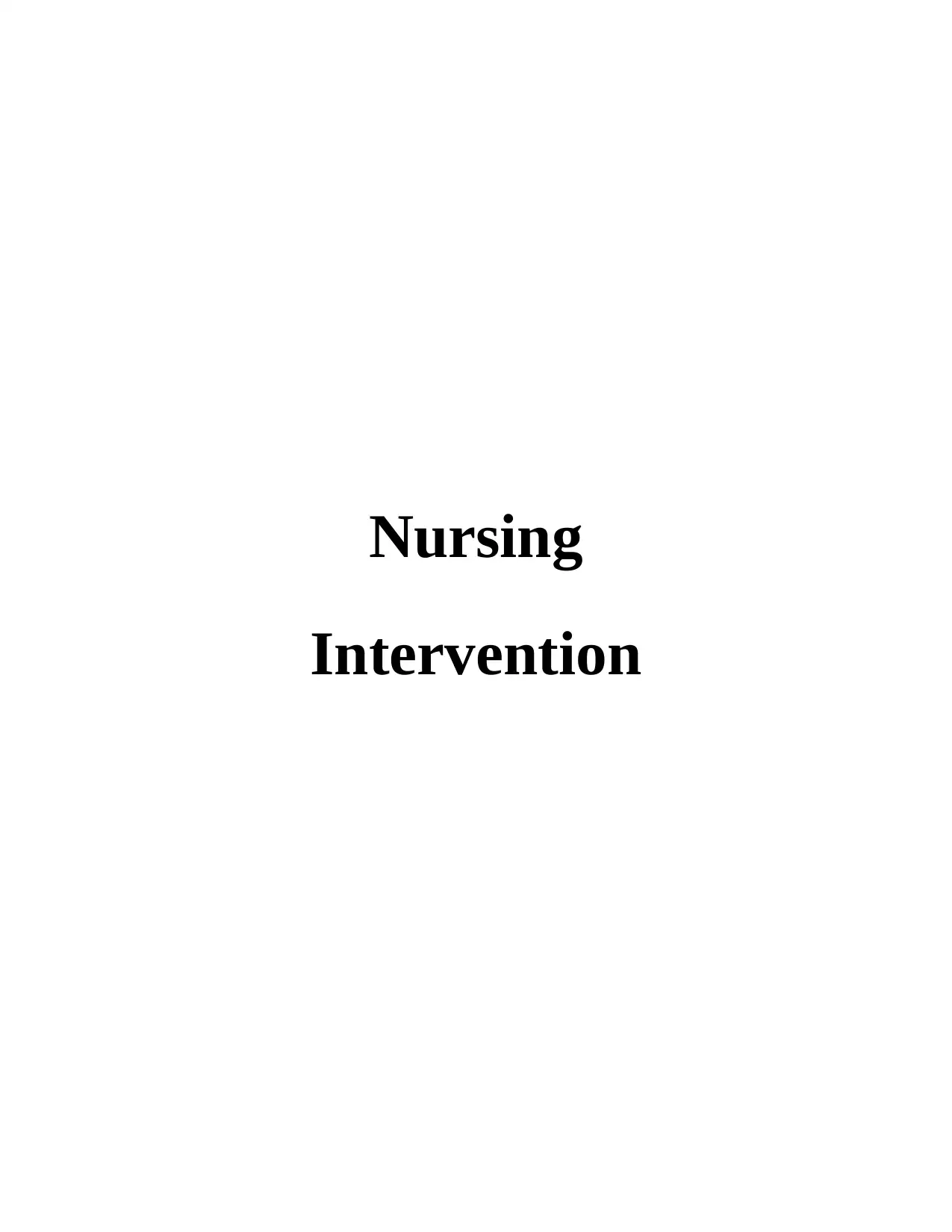
Nursing
Intervention
Intervention
Paraphrase This Document
Need a fresh take? Get an instant paraphrase of this document with our AI Paraphraser
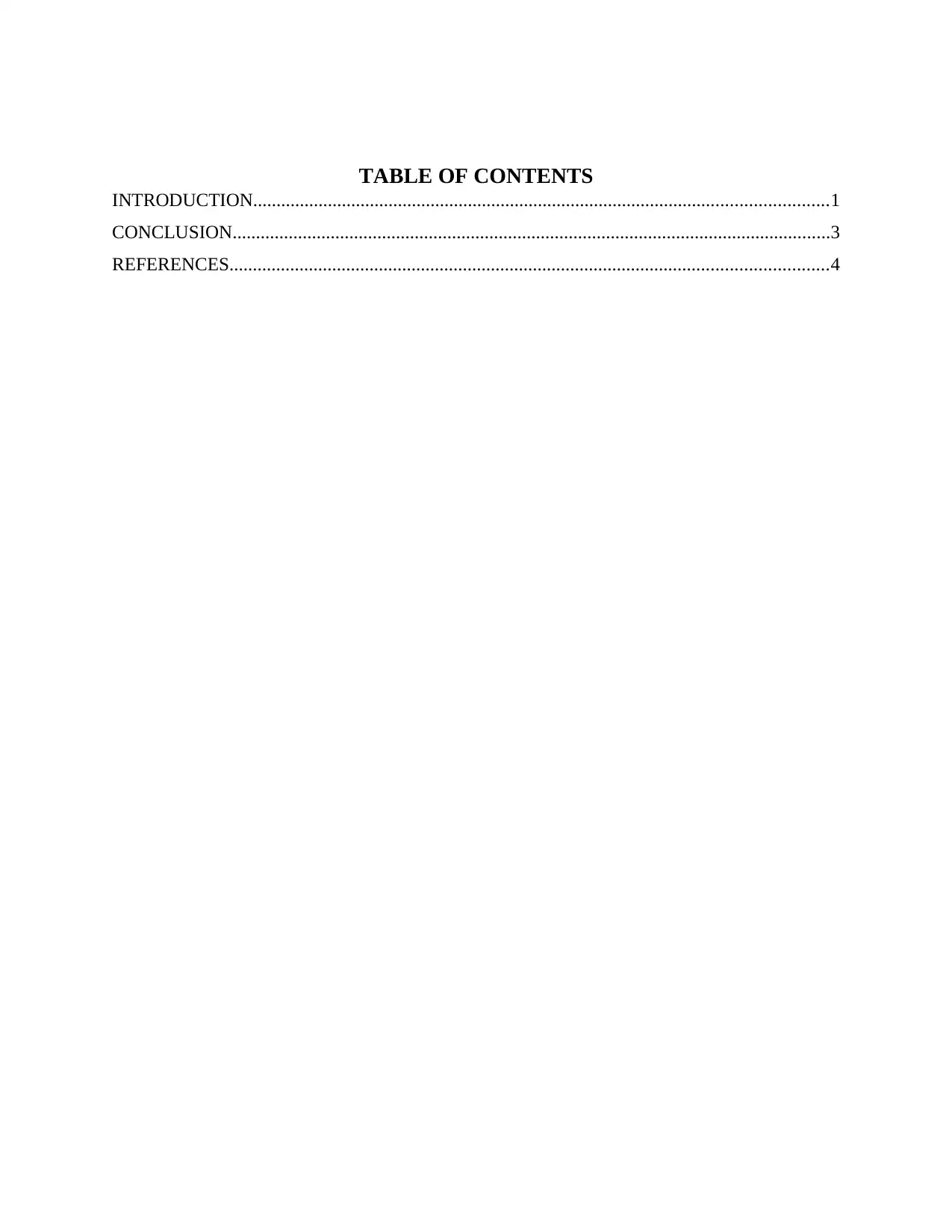
TABLE OF CONTENTS
INTRODUCTION...........................................................................................................................1
CONCLUSION................................................................................................................................3
REFERENCES................................................................................................................................4
INTRODUCTION...........................................................................................................................1
CONCLUSION................................................................................................................................3
REFERENCES................................................................................................................................4
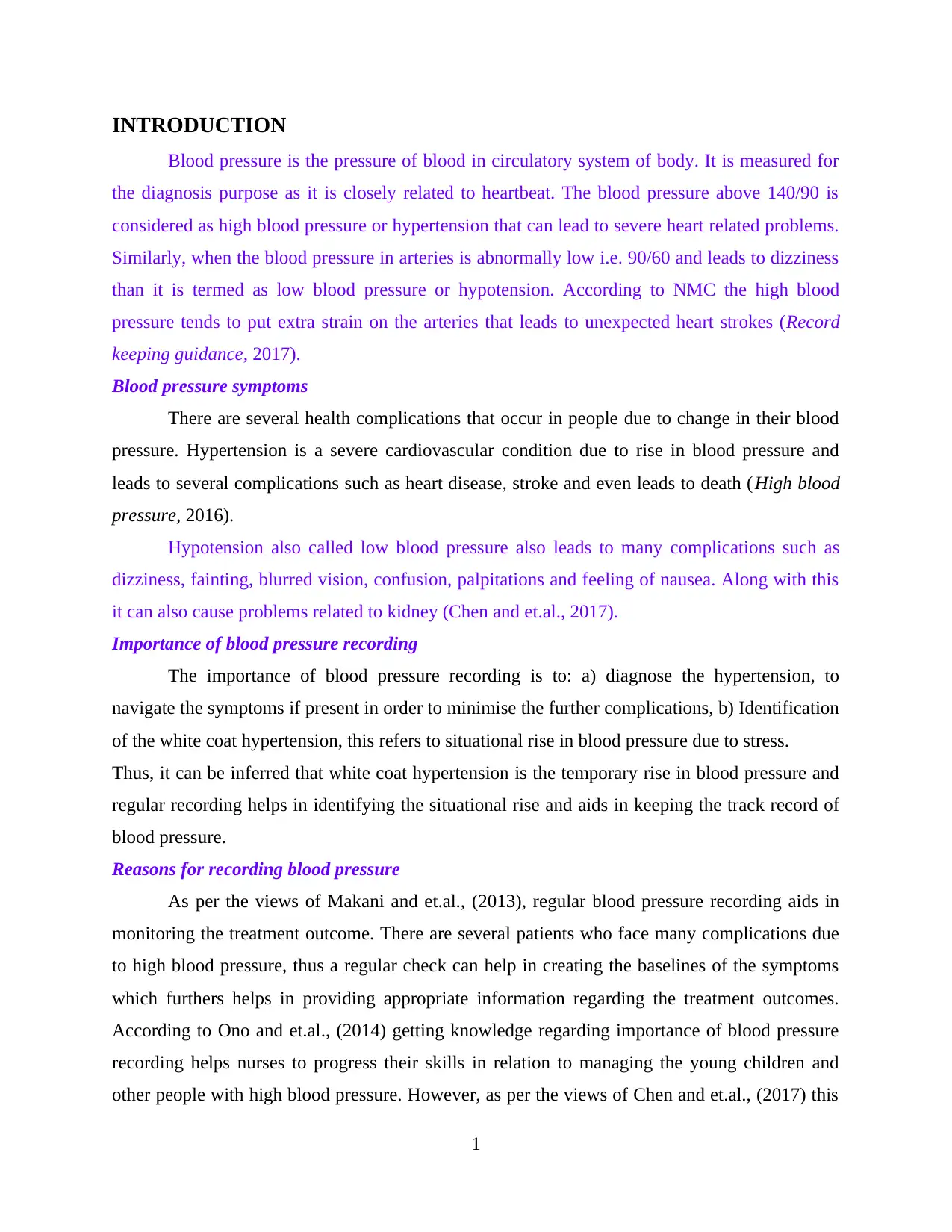
INTRODUCTION
Blood pressure is the pressure of blood in circulatory system of body. It is measured for
the diagnosis purpose as it is closely related to heartbeat. The blood pressure above 140/90 is
considered as high blood pressure or hypertension that can lead to severe heart related problems.
Similarly, when the blood pressure in arteries is abnormally low i.e. 90/60 and leads to dizziness
than it is termed as low blood pressure or hypotension. According to NMC the high blood
pressure tends to put extra strain on the arteries that leads to unexpected heart strokes (Record
keeping guidance, 2017).
Blood pressure symptoms
There are several health complications that occur in people due to change in their blood
pressure. Hypertension is a severe cardiovascular condition due to rise in blood pressure and
leads to several complications such as heart disease, stroke and even leads to death (High blood
pressure, 2016).
Hypotension also called low blood pressure also leads to many complications such as
dizziness, fainting, blurred vision, confusion, palpitations and feeling of nausea. Along with this
it can also cause problems related to kidney (Chen and et.al., 2017).
Importance of blood pressure recording
The importance of blood pressure recording is to: a) diagnose the hypertension, to
navigate the symptoms if present in order to minimise the further complications, b) Identification
of the white coat hypertension, this refers to situational rise in blood pressure due to stress.
Thus, it can be inferred that white coat hypertension is the temporary rise in blood pressure and
regular recording helps in identifying the situational rise and aids in keeping the track record of
blood pressure.
Reasons for recording blood pressure
As per the views of Makani and et.al., (2013), regular blood pressure recording aids in
monitoring the treatment outcome. There are several patients who face many complications due
to high blood pressure, thus a regular check can help in creating the baselines of the symptoms
which furthers helps in providing appropriate information regarding the treatment outcomes.
According to Ono and et.al., (2014) getting knowledge regarding importance of blood pressure
recording helps nurses to progress their skills in relation to managing the young children and
other people with high blood pressure. However, as per the views of Chen and et.al., (2017) this
1
Blood pressure is the pressure of blood in circulatory system of body. It is measured for
the diagnosis purpose as it is closely related to heartbeat. The blood pressure above 140/90 is
considered as high blood pressure or hypertension that can lead to severe heart related problems.
Similarly, when the blood pressure in arteries is abnormally low i.e. 90/60 and leads to dizziness
than it is termed as low blood pressure or hypotension. According to NMC the high blood
pressure tends to put extra strain on the arteries that leads to unexpected heart strokes (Record
keeping guidance, 2017).
Blood pressure symptoms
There are several health complications that occur in people due to change in their blood
pressure. Hypertension is a severe cardiovascular condition due to rise in blood pressure and
leads to several complications such as heart disease, stroke and even leads to death (High blood
pressure, 2016).
Hypotension also called low blood pressure also leads to many complications such as
dizziness, fainting, blurred vision, confusion, palpitations and feeling of nausea. Along with this
it can also cause problems related to kidney (Chen and et.al., 2017).
Importance of blood pressure recording
The importance of blood pressure recording is to: a) diagnose the hypertension, to
navigate the symptoms if present in order to minimise the further complications, b) Identification
of the white coat hypertension, this refers to situational rise in blood pressure due to stress.
Thus, it can be inferred that white coat hypertension is the temporary rise in blood pressure and
regular recording helps in identifying the situational rise and aids in keeping the track record of
blood pressure.
Reasons for recording blood pressure
As per the views of Makani and et.al., (2013), regular blood pressure recording aids in
monitoring the treatment outcome. There are several patients who face many complications due
to high blood pressure, thus a regular check can help in creating the baselines of the symptoms
which furthers helps in providing appropriate information regarding the treatment outcomes.
According to Ono and et.al., (2014) getting knowledge regarding importance of blood pressure
recording helps nurses to progress their skills in relation to managing the young children and
other people with high blood pressure. However, as per the views of Chen and et.al., (2017) this
1
⊘ This is a preview!⊘
Do you want full access?
Subscribe today to unlock all pages.

Trusted by 1+ million students worldwide
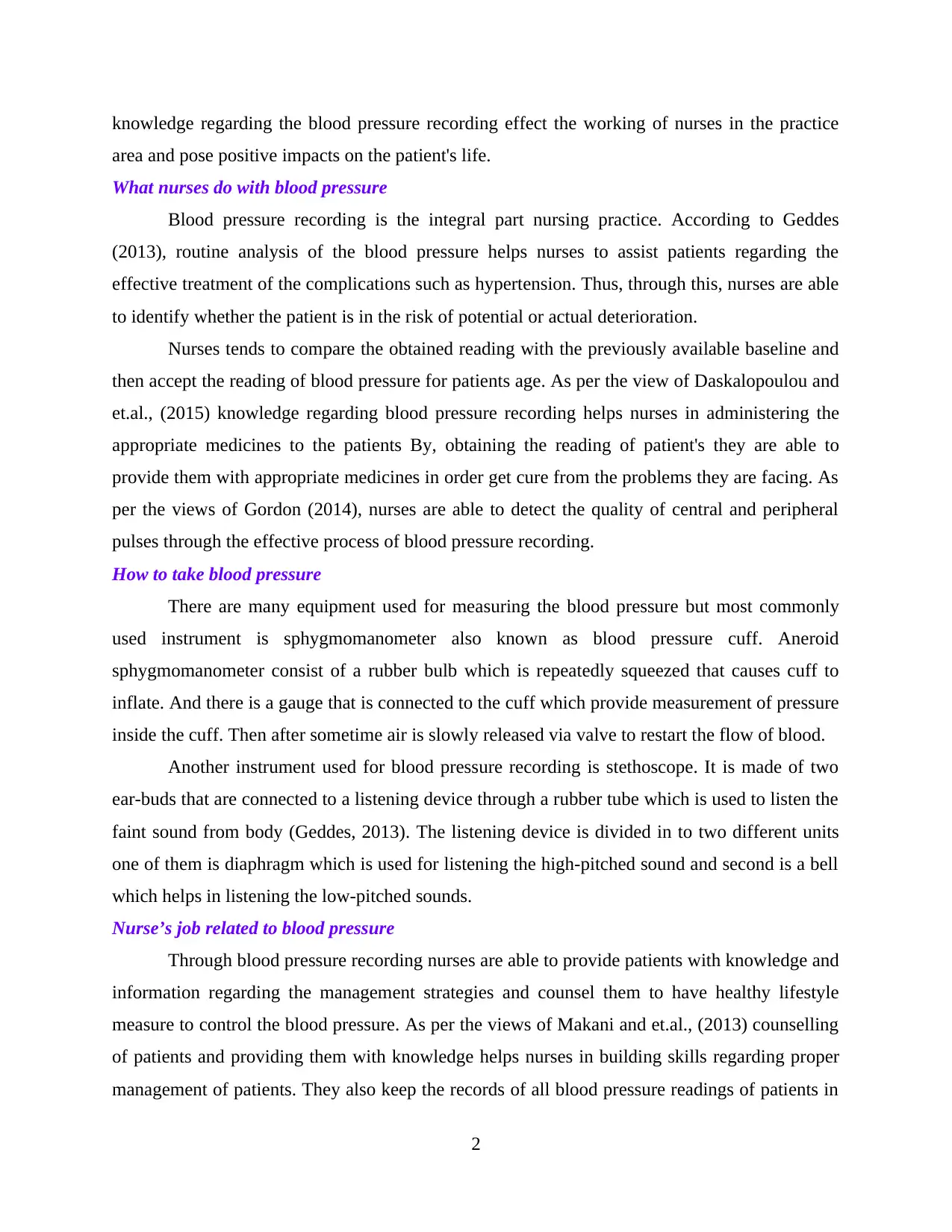
knowledge regarding the blood pressure recording effect the working of nurses in the practice
area and pose positive impacts on the patient's life.
What nurses do with blood pressure
Blood pressure recording is the integral part nursing practice. According to Geddes
(2013), routine analysis of the blood pressure helps nurses to assist patients regarding the
effective treatment of the complications such as hypertension. Thus, through this, nurses are able
to identify whether the patient is in the risk of potential or actual deterioration.
Nurses tends to compare the obtained reading with the previously available baseline and
then accept the reading of blood pressure for patients age. As per the view of Daskalopoulou and
et.al., (2015) knowledge regarding blood pressure recording helps nurses in administering the
appropriate medicines to the patients By, obtaining the reading of patient's they are able to
provide them with appropriate medicines in order get cure from the problems they are facing. As
per the views of Gordon (2014), nurses are able to detect the quality of central and peripheral
pulses through the effective process of blood pressure recording.
How to take blood pressure
There are many equipment used for measuring the blood pressure but most commonly
used instrument is sphygmomanometer also known as blood pressure cuff. Aneroid
sphygmomanometer consist of a rubber bulb which is repeatedly squeezed that causes cuff to
inflate. And there is a gauge that is connected to the cuff which provide measurement of pressure
inside the cuff. Then after sometime air is slowly released via valve to restart the flow of blood.
Another instrument used for blood pressure recording is stethoscope. It is made of two
ear-buds that are connected to a listening device through a rubber tube which is used to listen the
faint sound from body (Geddes, 2013). The listening device is divided in to two different units
one of them is diaphragm which is used for listening the high-pitched sound and second is a bell
which helps in listening the low-pitched sounds.
Nurse’s job related to blood pressure
Through blood pressure recording nurses are able to provide patients with knowledge and
information regarding the management strategies and counsel them to have healthy lifestyle
measure to control the blood pressure. As per the views of Makani and et.al., (2013) counselling
of patients and providing them with knowledge helps nurses in building skills regarding proper
management of patients. They also keep the records of all blood pressure readings of patients in
2
area and pose positive impacts on the patient's life.
What nurses do with blood pressure
Blood pressure recording is the integral part nursing practice. According to Geddes
(2013), routine analysis of the blood pressure helps nurses to assist patients regarding the
effective treatment of the complications such as hypertension. Thus, through this, nurses are able
to identify whether the patient is in the risk of potential or actual deterioration.
Nurses tends to compare the obtained reading with the previously available baseline and
then accept the reading of blood pressure for patients age. As per the view of Daskalopoulou and
et.al., (2015) knowledge regarding blood pressure recording helps nurses in administering the
appropriate medicines to the patients By, obtaining the reading of patient's they are able to
provide them with appropriate medicines in order get cure from the problems they are facing. As
per the views of Gordon (2014), nurses are able to detect the quality of central and peripheral
pulses through the effective process of blood pressure recording.
How to take blood pressure
There are many equipment used for measuring the blood pressure but most commonly
used instrument is sphygmomanometer also known as blood pressure cuff. Aneroid
sphygmomanometer consist of a rubber bulb which is repeatedly squeezed that causes cuff to
inflate. And there is a gauge that is connected to the cuff which provide measurement of pressure
inside the cuff. Then after sometime air is slowly released via valve to restart the flow of blood.
Another instrument used for blood pressure recording is stethoscope. It is made of two
ear-buds that are connected to a listening device through a rubber tube which is used to listen the
faint sound from body (Geddes, 2013). The listening device is divided in to two different units
one of them is diaphragm which is used for listening the high-pitched sound and second is a bell
which helps in listening the low-pitched sounds.
Nurse’s job related to blood pressure
Through blood pressure recording nurses are able to provide patients with knowledge and
information regarding the management strategies and counsel them to have healthy lifestyle
measure to control the blood pressure. As per the views of Makani and et.al., (2013) counselling
of patients and providing them with knowledge helps nurses in building skills regarding proper
management of patients. They also keep the records of all blood pressure readings of patients in
2
Paraphrase This Document
Need a fresh take? Get an instant paraphrase of this document with our AI Paraphraser
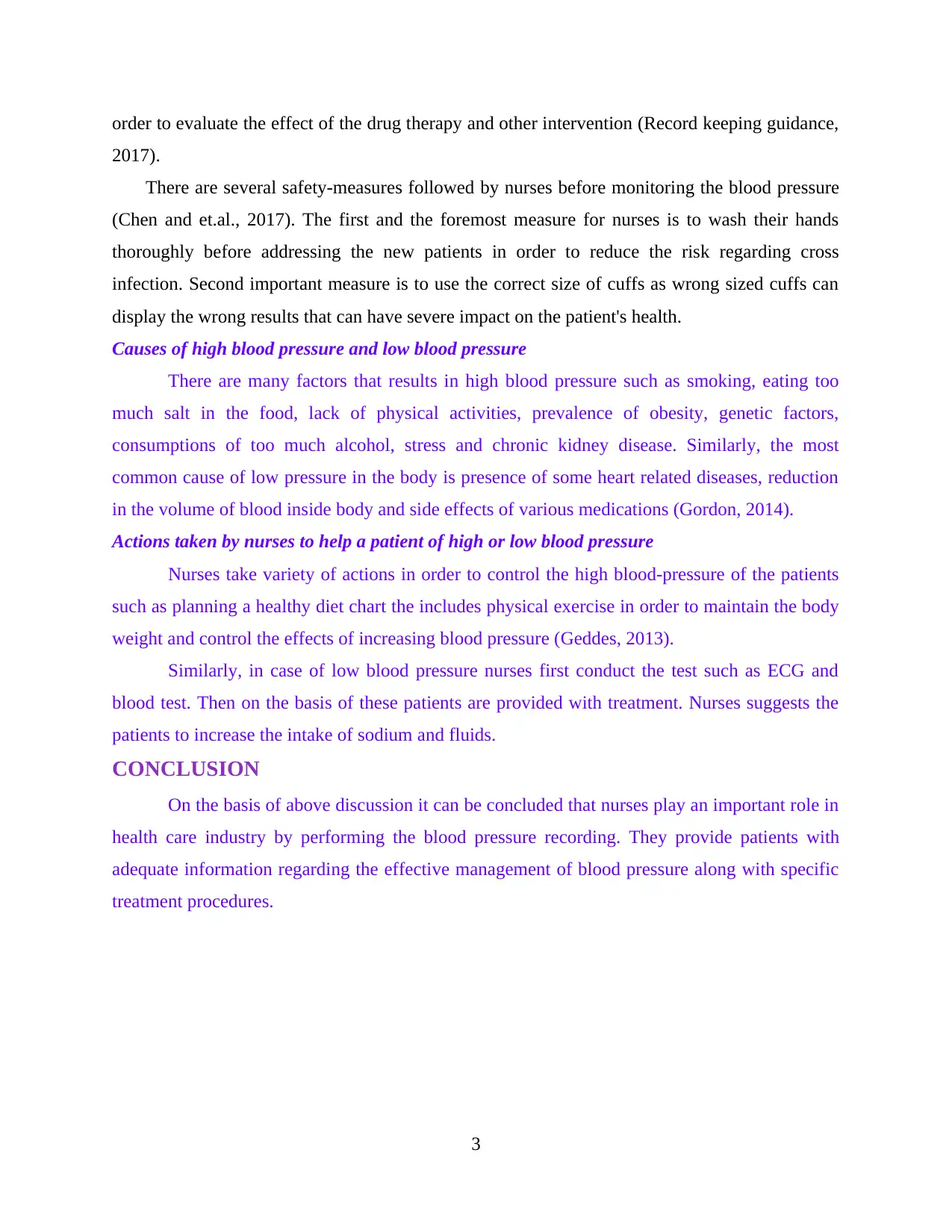
order to evaluate the effect of the drug therapy and other intervention (Record keeping guidance,
2017).
There are several safety-measures followed by nurses before monitoring the blood pressure
(Chen and et.al., 2017). The first and the foremost measure for nurses is to wash their hands
thoroughly before addressing the new patients in order to reduce the risk regarding cross
infection. Second important measure is to use the correct size of cuffs as wrong sized cuffs can
display the wrong results that can have severe impact on the patient's health.
Causes of high blood pressure and low blood pressure
There are many factors that results in high blood pressure such as smoking, eating too
much salt in the food, lack of physical activities, prevalence of obesity, genetic factors,
consumptions of too much alcohol, stress and chronic kidney disease. Similarly, the most
common cause of low pressure in the body is presence of some heart related diseases, reduction
in the volume of blood inside body and side effects of various medications (Gordon, 2014).
Actions taken by nurses to help a patient of high or low blood pressure
Nurses take variety of actions in order to control the high blood-pressure of the patients
such as planning a healthy diet chart the includes physical exercise in order to maintain the body
weight and control the effects of increasing blood pressure (Geddes, 2013).
Similarly, in case of low blood pressure nurses first conduct the test such as ECG and
blood test. Then on the basis of these patients are provided with treatment. Nurses suggests the
patients to increase the intake of sodium and fluids.
CONCLUSION
On the basis of above discussion it can be concluded that nurses play an important role in
health care industry by performing the blood pressure recording. They provide patients with
adequate information regarding the effective management of blood pressure along with specific
treatment procedures.
3
2017).
There are several safety-measures followed by nurses before monitoring the blood pressure
(Chen and et.al., 2017). The first and the foremost measure for nurses is to wash their hands
thoroughly before addressing the new patients in order to reduce the risk regarding cross
infection. Second important measure is to use the correct size of cuffs as wrong sized cuffs can
display the wrong results that can have severe impact on the patient's health.
Causes of high blood pressure and low blood pressure
There are many factors that results in high blood pressure such as smoking, eating too
much salt in the food, lack of physical activities, prevalence of obesity, genetic factors,
consumptions of too much alcohol, stress and chronic kidney disease. Similarly, the most
common cause of low pressure in the body is presence of some heart related diseases, reduction
in the volume of blood inside body and side effects of various medications (Gordon, 2014).
Actions taken by nurses to help a patient of high or low blood pressure
Nurses take variety of actions in order to control the high blood-pressure of the patients
such as planning a healthy diet chart the includes physical exercise in order to maintain the body
weight and control the effects of increasing blood pressure (Geddes, 2013).
Similarly, in case of low blood pressure nurses first conduct the test such as ECG and
blood test. Then on the basis of these patients are provided with treatment. Nurses suggests the
patients to increase the intake of sodium and fluids.
CONCLUSION
On the basis of above discussion it can be concluded that nurses play an important role in
health care industry by performing the blood pressure recording. They provide patients with
adequate information regarding the effective management of blood pressure along with specific
treatment procedures.
3
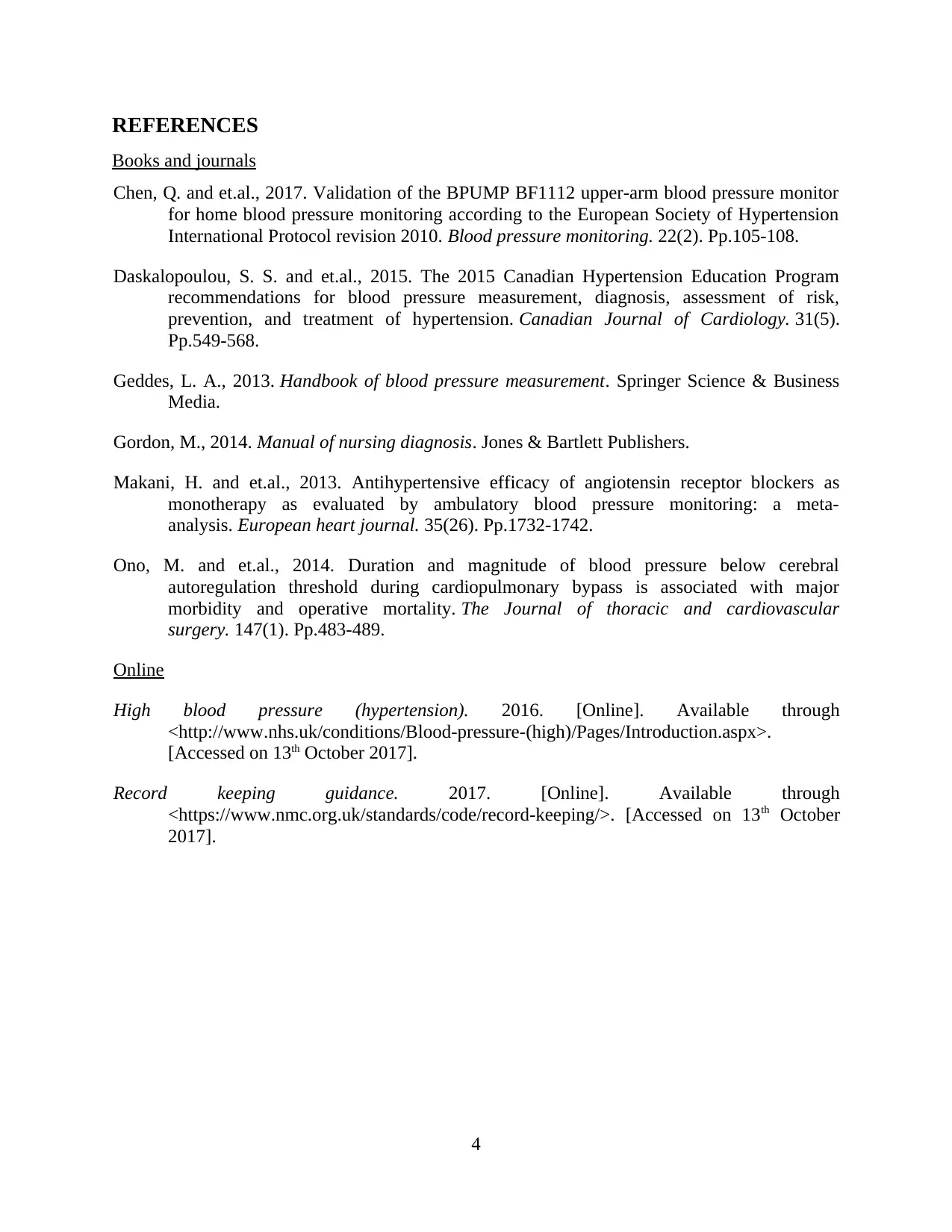
REFERENCES
Books and journals
Chen, Q. and et.al., 2017. Validation of the BPUMP BF1112 upper-arm blood pressure monitor
for home blood pressure monitoring according to the European Society of Hypertension
International Protocol revision 2010. Blood pressure monitoring. 22(2). Pp.105-108.
Daskalopoulou, S. S. and et.al., 2015. The 2015 Canadian Hypertension Education Program
recommendations for blood pressure measurement, diagnosis, assessment of risk,
prevention, and treatment of hypertension. Canadian Journal of Cardiology. 31(5).
Pp.549-568.
Geddes, L. A., 2013. Handbook of blood pressure measurement. Springer Science & Business
Media.
Gordon, M., 2014. Manual of nursing diagnosis. Jones & Bartlett Publishers.
Makani, H. and et.al., 2013. Antihypertensive efficacy of angiotensin receptor blockers as
monotherapy as evaluated by ambulatory blood pressure monitoring: a meta-
analysis. European heart journal. 35(26). Pp.1732-1742.
Ono, M. and et.al., 2014. Duration and magnitude of blood pressure below cerebral
autoregulation threshold during cardiopulmonary bypass is associated with major
morbidity and operative mortality. The Journal of thoracic and cardiovascular
surgery. 147(1). Pp.483-489.
Online
High blood pressure (hypertension). 2016. [Online]. Available through
<http://www.nhs.uk/conditions/Blood-pressure-(high)/Pages/Introduction.aspx>.
[Accessed on 13th October 2017].
Record keeping guidance. 2017. [Online]. Available through
<https://www.nmc.org.uk/standards/code/record-keeping/>. [Accessed on 13th October
2017].
4
Books and journals
Chen, Q. and et.al., 2017. Validation of the BPUMP BF1112 upper-arm blood pressure monitor
for home blood pressure monitoring according to the European Society of Hypertension
International Protocol revision 2010. Blood pressure monitoring. 22(2). Pp.105-108.
Daskalopoulou, S. S. and et.al., 2015. The 2015 Canadian Hypertension Education Program
recommendations for blood pressure measurement, diagnosis, assessment of risk,
prevention, and treatment of hypertension. Canadian Journal of Cardiology. 31(5).
Pp.549-568.
Geddes, L. A., 2013. Handbook of blood pressure measurement. Springer Science & Business
Media.
Gordon, M., 2014. Manual of nursing diagnosis. Jones & Bartlett Publishers.
Makani, H. and et.al., 2013. Antihypertensive efficacy of angiotensin receptor blockers as
monotherapy as evaluated by ambulatory blood pressure monitoring: a meta-
analysis. European heart journal. 35(26). Pp.1732-1742.
Ono, M. and et.al., 2014. Duration and magnitude of blood pressure below cerebral
autoregulation threshold during cardiopulmonary bypass is associated with major
morbidity and operative mortality. The Journal of thoracic and cardiovascular
surgery. 147(1). Pp.483-489.
Online
High blood pressure (hypertension). 2016. [Online]. Available through
<http://www.nhs.uk/conditions/Blood-pressure-(high)/Pages/Introduction.aspx>.
[Accessed on 13th October 2017].
Record keeping guidance. 2017. [Online]. Available through
<https://www.nmc.org.uk/standards/code/record-keeping/>. [Accessed on 13th October
2017].
4
⊘ This is a preview!⊘
Do you want full access?
Subscribe today to unlock all pages.

Trusted by 1+ million students worldwide
1 out of 6
Related Documents
Your All-in-One AI-Powered Toolkit for Academic Success.
+13062052269
info@desklib.com
Available 24*7 on WhatsApp / Email
![[object Object]](/_next/static/media/star-bottom.7253800d.svg)
Unlock your academic potential
Copyright © 2020–2025 A2Z Services. All Rights Reserved. Developed and managed by ZUCOL.





